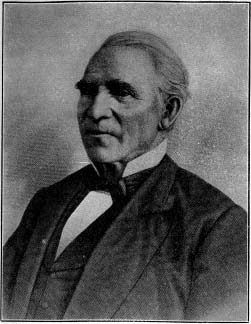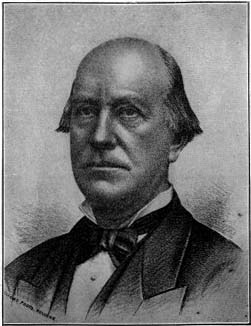|
Sketch of Holyoke by George H. Allyn, page 3 The building of a great wooden damn was commenced, one thousand feet long, with stone abutments at each end. Over two million feet of lumber were used, mainly hemlock, floated down the river from Vermont and New Hampshire. The sides of the dam were large timbers, forty feet or more long. The front was perpendicular and the crest was protected with strips of boiler iron, six to eight feet long. The overall projected twelve feet beyond the crest. Across the full length of the dam was a footbridge, three feet wide, intended for inspecting the dam. On November 16, 1848, at ten minutes of 10 a.m., the gates were opened and the water shut off from the bed of the river below the dam, leaving it dry save for little pools in hollows of the rock, where stranded fish congregated. Crowds viewed the spectacle. About noon a small spurt of water was noticed at the base of the dam, and then the water began to ooze through the masonry at the west end. Three veteran boatman with others manned a flatboat and tried to stop the leaks, but at 3:20 p.m. the water poured through so that they hastened for shore, which they had barely reached when the dam gave way with a roar, said to have been heard in Granby; but those Granbyites always told big stories anyway, and the habit continues to the present day. The water swept over Main street, South Hadley Falls, and drowned a horse tied to a post, reaching the foot of Lamoreaux terrace. J.K. Mills, the South Hadley Falls agent, kept the telegraph line to Boston humming, giving the height to which the water had risen, but at 3:30 he telegraphed the historic message: "Dam gone to hell by way of Willimansett." Undiscouraged, a new dam was built and completed on October 22, 1849, which stood the test, costing $150,000. Already the mills, afterward known as the Lyman and Hadley Mills, were started by Charles MacClallan of Chicopee, the Hadley Mills being designed for machine shops. The Glasgow Company had also been organized across the river, and Mr. MacClallan started building their mills in 1849. The Hadley cottages were also started in 1848, and the "Cataract House" opened as a hotel. The Lyman Mills started manufacturing April 23, 1850. The Lyman Mills corporation was not organized till 1853 or 1854, but two mills were operated before that date, and a third, built in 1873, and still others only a few years ago. Seven brick blocks, comprising two hundred and five tenements, were built for the company. The first agent of the company was succeeded by Jones S. Davis, who remained from 1853 to 1871, built the hotel at Ingleside, afterwards destroyed by fire, was during this period Holyoke's greatest benefactor, and universally known as "Agent" Davis. The building of the two dams, and the mills and the tenements, of course, attracted hundreds of workmen, and the prospect of mill employment many others, so that on March 14, 1850, the town was organized with its present boundaries and about 2,500 people. The selectmen for 1851 were Fayette Smith and Hervey Chapin, the latter's residence still standing at the corner of Northampton street and Chapin avenue. The Hadley Falls Company seem to have figured Holyoke for a "cotton town," and the call for help went forth among the New England boys and girls, but the supply was insufficient. Members of families whose husbands and fathers had worked on the dams and canals, entered the mills, and many came from Ireland and Canada. The father of Joseph, John and G.J. Prew was for some years employed by the Lyman Mills to bring workers from Canada, making the journey in big teams. In 1853 the Parsons Paper Company was organized by J.C. Parsons, and the first paper mills built on the river bank near the dam the same year. More people came in. The Hadley Falls bank had been organized in 1851, with a capital of $10,000. The first high school had been opened in 1852 with Stephen Holman as principal. The Second Congregational Church had "started in" about 1848, holding serves in the schoolhouse, then located near the Lyman Mills, and later in the brick schoolhouse, and in Exchange Hall, on High street. The first business block, the Gallaudet-Terry block, had been built in 1849 at the corner of High and Lyman streets, and the Exchange block a year or two later. Rev. Mr. Pierce was the first pastor and the church at the corner of High and Dwight streets was completed in 1853, and used until December, 1884. The Second Baptist Church had been organized in 1849, and held services in Gallaudet-Terry's hall, later in Chapin Hall, at the foot of Dwight street, and their new church south of Holyoke Water Power company's office was completed in 1859. The Methodist Church was also organized in 1853, but didn't build their edifice at the corner of Main and Appleton streets till 1869. Lester Newell seems to have been the first attorney, having been admitted to the bar in 1845, and later holding the office of trial justice. C.H. Branscombe was admitted in 1849, and W.B.C. Pearsons in 1850, and a few years later Porter Underwood and Moses Chapin. A fire department was organized soon after Holyoke became a town, and Robert J. Marsh was the first chief. Later on R.P. Crafts, Lawyer Pearsons and other men of note served, and 'tis said that one time when "Bob" Marsh wanted a re-election, but knew he was slated for defeat, he solicited the members to elect him on pledge of resigning at once, but forgot it the moment the votes were counted. The next year he was not a candidate for re-election. A photograph of Holyoke, seemingly taken by F.W. Haskins about 1853, shows the territory form High street east to the present Hotel Hamilton with nothing intervening but the first level canal.
Depot Hill shows for the most part deeply wooded, being then mainly the Sam Ely farm. The late Charles B. Prescott told the writer that about 1858 there was quite a demand for coons for coon suppers. A boy named Moffat, whose father kept a drug store, came to his comrades with a sponge and a bottle of alcohol, secured from the parental store, and the brilliant idea of capturing a mud turtle, boring two holes in his shell, running a cord with sponge saturated in alcohol between the two orifices, placing the reptile at the mouth of a woodchuck's hole, setting fire to the alcohol, and, as the blazing tortoise crawled in, the unhappy woodchuck, thinking he was infernally "sent for," would sally forth into a bag held wide for his entrance. As the boys climbed over Uncle Sam Ely's fence somewhere at the corner of West and Ely street, the old man sighted them and yelled: "Come back here, you two cotton tops," but upon explaining their plan he became interested and gave them carte blanche. Several woodchucks were captured, killed, skinned, and sold for coons, and at one time Mr. Prescott, "We had as much as five dollars in the treasury." The first Catholic service is said to have been held by Father Bartholomew O'Connor in the open air, beneath a tree, somewhere in the vicinity of Lyman and Front streets. Later priests from Chicopee conducted services until the advent of Father John O'Callaghan, the first parish priest, the date of whose settlement is placed by some as 1854 and by others as 1856. In any event he started the building of St. Jerome's Church in 1856, having, as he said, "raised ten thousand dollars from friends throughout the valley, including quite a number of Protestants." Father O'Callaghan must have been an able man, as works written by him are still in print. He became involved in a controversy with the Rev. Mr. Walker, pastor of the Second Congregational Church, and is said to have more than held up his end of it. He did not believe in hired pew sittings, holding that all should have the opportunity to worship without price, and should contribute to the full measure of their ability. St. Jerome's Church was finished about 1859-60, and Father O'Callaghan died at a period nearly coincident with it, being succeeded by Father Sullivan, who was succeeded in 1866, by the Rev. P.J. Harkins, who had a record-breaking term of pastoral service. As the present Elm street school (formerly the high school) was not built until 1862, the high school from 1852 to 1862 was carried on in various locations, the first, like that of some of the churches, being in the Gallaudet-Terry block, still standing at the corner of High and Lyman streets. From this, previous to 1860, was graduated William S. Loomis, Thomas W. Mann, and possibly several others yet living. Mr. Loomis relates that at one time a reckless piece of mischief was done without there being a single clue to the identity of the scholar perpetrating it. But the principal unhesitatingly called forward six boys (including W.S.) and five of the six were guilty culprits.
| Previous Page | Next Page |
| People & Organizations | Allyn's Sketch of Holyoke |
| Selected Advertisments | Churches | Surname Index |
© Laurel O'Donnell 1996 - 2005, all rights reserved
This document may be downloaded for personal non-commercial use only and should not be reproduced or distributed without permission. |

